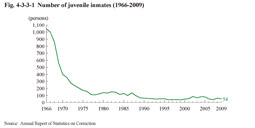Section 3 Juvenile Inmates
Fig. 4-3-3-1 shows the number of new inmates younger than 20 at the time of admission (including those 20 or older at the time of admission but younger than 20 when they received an indeterminate sentence; hereinafter referred to as “new juvenile inmates”) since 1966. The number exceeded 1,000 in 1966 but then decreased significantly, and has remained below 100 since 1988. In 2009 it was 54 (down 9 from the previous year).
Fig. 4-3-3-1 Number of juvenile inmates (1966-2009)
Juvenile inmates newly admitted in 2009 were all males. By age at the time of admission (age at the time they received an indeterminate sentence with those 20 or older when admitted) two were 16 or 17, and 52 were 18 or 19. Examining the number of new juvenile inmates by term of sentence (maximum term with indeterminate sentences) revealed that two of them were sentenced to life imprisonment, one to “more than 10 years but 15 years or less,” 27 to “more than 5 years but 10 years or less,” 14 to “more than 3 years but 5 years or less,” and 10 to 3 years or less. By type of sentencing 50 were sentenced to imprisonment with work and four to imprisonment without work. By type of offense injury was the largest in number at 14 (injury four, injury causing death 10), followed by robbery at 13 (robbery one, robbery causing death or injury 10, rape at the scene of a robbery / rape at the scene of a robbery causing death two), homicide at six, negligence in vehicle driving / negligence in the pursuit of social activities causing death or injury at five, rape (including rape causing death or injury) at four, and dangerous driving causing death or injury at three (Source: Annual Report of Statistics on Correction).
